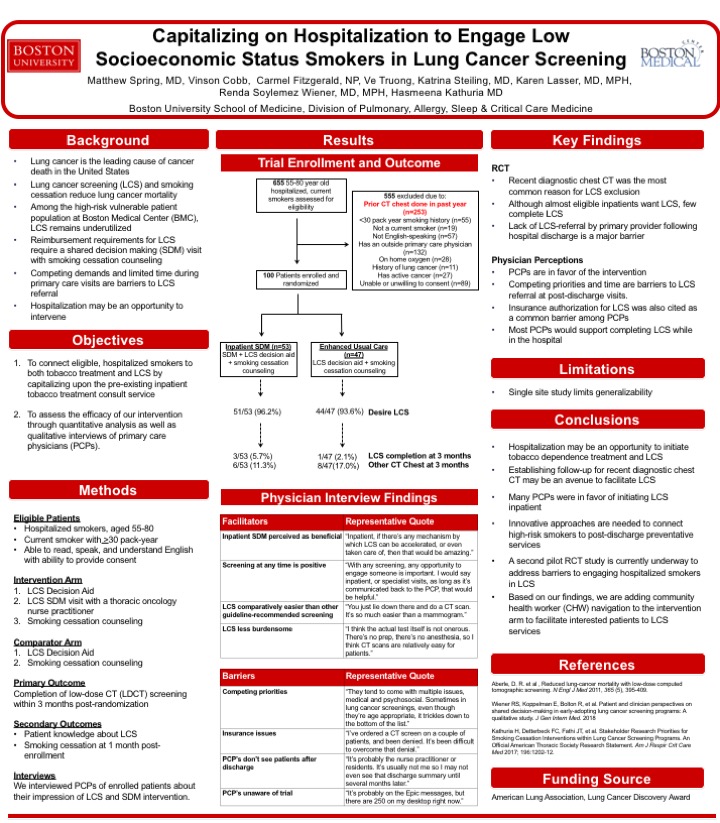Capitalizing on Hospitalization to Engage Low Socioeconomic Status Smokers in Lung Cancer Screening

Matt Spring, MD
Matthew Spring, Vinson Cobb, Carmel Fitzgerald, Cornelia Wakeman, Ve Truong, Katrina Steiling, Karen Lasser, Renda Wiener, Hasmeena Kathuria.
Objectives: Smoking cessation and lung cancer screening (LCS) reduce lung cancer mortality. However, among the high-risk, vulnerable patient population at our safety-net hospital, LCS remains underutilized. We sought to understand whether initiating shared decision-making (SDM) for LCS during hospitalization could increase screening rates among high-risk smokers.
Methods: We assessed hospitalized patients for LCS eligibility and then randomized screen-eligible smokers to receive either Inpatient SDM (SDM by nurse practitioner) or Enhanced Usual Care (furnishing of an LCS decision aid) during inpatient smoking cessation counseling visits. For Inpatient SDM, primary care providers were notified of the patient’s decision regarding LCS. We assessed completion of LCS within 3 months post-randomization. To explore barriers to the low rates of LCS completion, we conducted semi-structured interviews with primary care providers (n=10).
Results: Of 655 patients screened for eligibility, nearly 40% were ineligible due to recent diagnostic chest CT, the most common reason for exclusion. Of the enrolled 100 patients, more than 90% desired LCS, but fewer than 10% completed LCS for each arm. Qualitative interviews showed that while most primary care providers favorably viewed our intervention, competing priorities were barriers to LCS referral.
Conclusion: While hospitalization may be an opportunity to initiate tobacco dependence treatment and engage patients in SDM about LCS, innovative approaches are needed to connect high-risk smokers to post-discharge preventative services. A second pilot study, utilizing community health workers, is currently underway.
4 comments
HI Matt, This work helps identify the areas we will need to focus efforts to optimize engagement of patients with their PCPs in obtaining the LCS for eligible patients post-discharge. Utilization of community health workers will be an important innovation.
Matt, terrific study of a very important, practical problem!! It seems that a combined strategy of identifying patients at risk to fail to engage LCS as an outpatient could be used to triage patients to inpatient or outpatient screening. The Community Health Worker will be an interesting intervention!
Well-done! Dave
Important and eye opening findings. Engaging the PCPs and their associates (PAs, etc) seems essential for success. David
Matt, excellent work! The comprehensive nature of the study highlights both intentions and barriers on the side of patients and providers. I hope community HCW can close the gap between patient’s desire for screening and actually being screened.